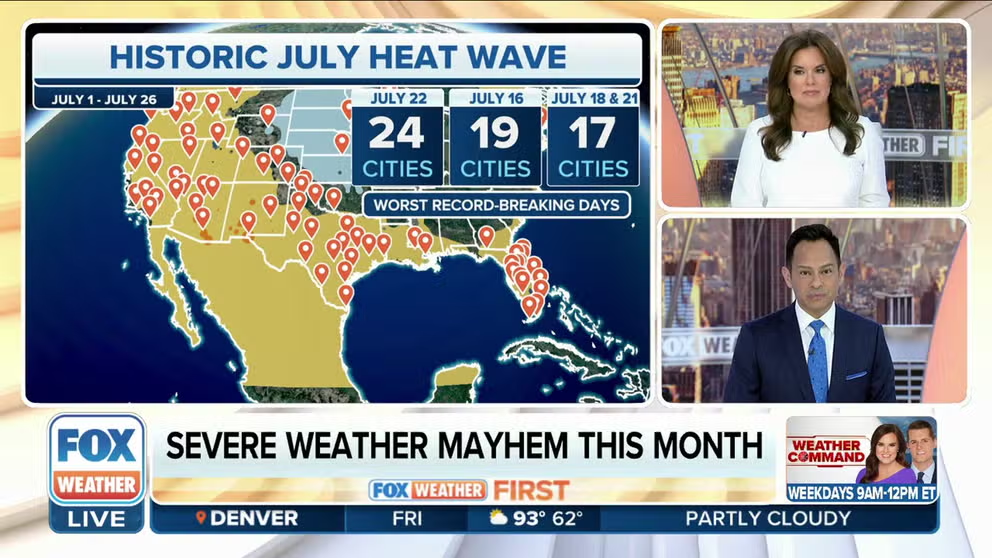Weekend Weather Wows: Historic American heat wave by the numbers
For this week's edition, I will try to corral much of the heat weather records that have fallen since the start of the month to put this historic event into perspective.
Breaking down all the records from America's historic July heat wave
From coast to coast, all time heat records have been shattered as a persistent ridge of high pressure baked the southern tier of the U.S. throughout July.
PHOENIX – It's a good thing most historical weather observations are kept electronically these days because otherwise, the amount of ink that would be needed to rewrite all the record books this month could plunge the pen industry into a national supply crisis.
It's time for our weekly feature, "Weekend Weather Wows," where we go back and find the most exciting tidbits of weather you might have missed over the past week, so you'll be ready to impress at the water cooler (or virtual water cooler) come Monday.
For this week's edition, I will try to corral much of the heat wave weather records that have fallen since the start of the month to put this historic event into perspective. Each one is a "wow" unto itself, but in the aggregate, it goes into at least "holy cow," if not pushing more PG-13 exclamations.
The setup: The ridge that wouldn't budge
A massive heat dome became anchored in the Desert Southwest after nudging west from rewriting Texas' record books in June, but its influence spread across the entire southern tier of the U.S.
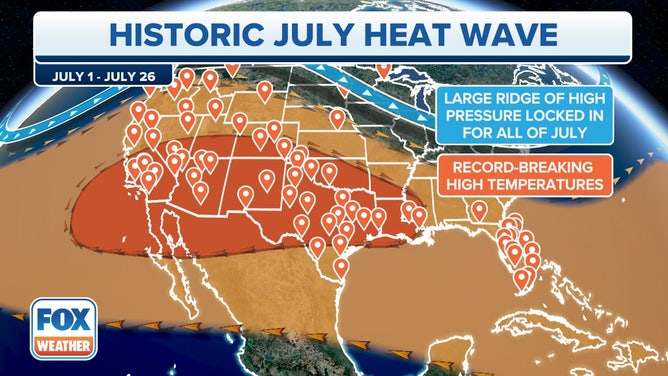
(FOX Weather)
The pattern itself wouldn't be considered that unusual for summer for a brief period, but its length and intensity were far beyond average.
Over the entire nation, some 222 daily record high temperatures have been set across 76 major reporting stations, spreading from the Northwest down into the Desert Southwest and east across Texas and then into Florida.
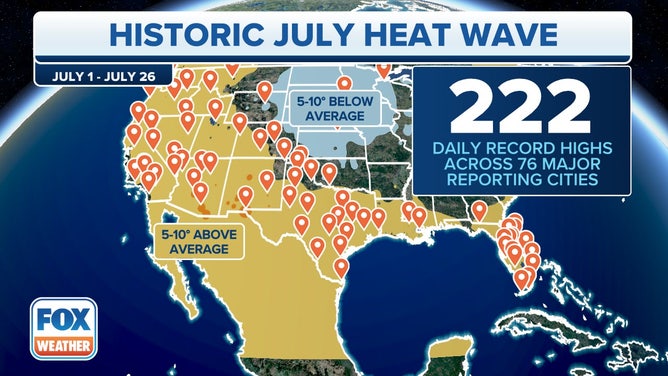
(FOX Weather)
On July 16, 19 major cities reached record highs, followed by 17 major city record highs on July 18 and again on July 21. Then, July 22 set records in 24 major cities.

(FOX Weather)
Sunshine State becomes the Too-Much-Sunshine State
Starting our cross-country trek in the East, we find Floridians who have probably never welcomed such a soggy forecast as the one that's gracing their forecast this weekend, finally bringing some heat wave relief.
South Florida had heat alerts in effect for more than two weeks as highs climbed well into the 90s, with dew points reaching extreme levels – near 80 degrees – that even a humidity capital such as Florida has rarely experienced. Put that together, and much of central and south Florida had several days of "feels like" temperatures of 105-110 degrees. Miami had 16 days feeling like 105 or hotter.
Marathon, in the Florida Keys, is ready to run away to cooler locales (though it wasn't much cooler anywhere close by). The town reached 99 degrees twice this month – tying their all-time record high – and setting daily high-temperature records on 19 other days, reaching 97 and 98 several other times.
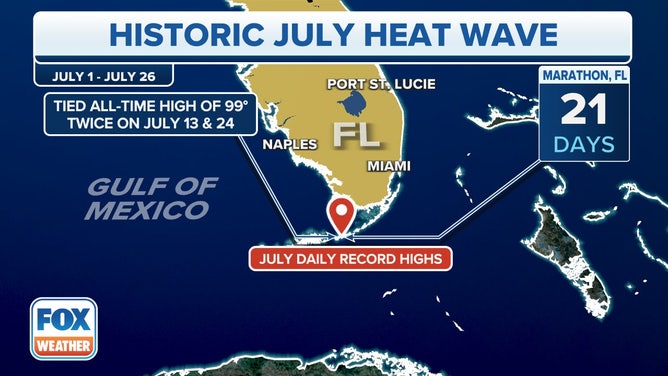
(FOX Weather)
Key West, Miami, Vero Beach, Fort Myers, Sarasota and Tampa are all at their hottest month on record (of any month) through July 26.

(FOX Weather)
Arizona: Dry heat or not, it's way too hot
The heat was no easier in the Southwest. Sure, the humidity was considerably lower, but they didn't need it to reach "feels-like" temperatures over 110 degrees because the actual temperature reached 110 or more on its own.
Phoenix set 11 daily high-temperature records this month, while Tucson has set 10.
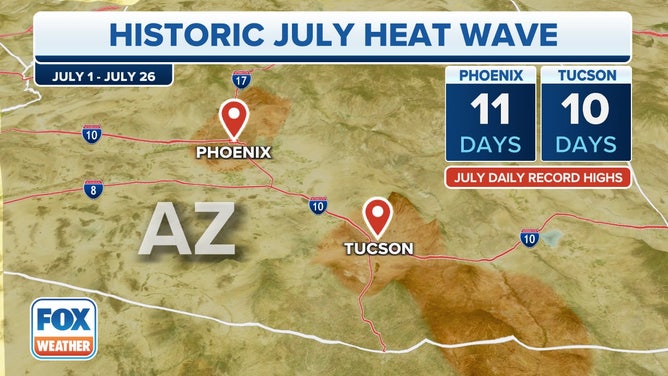
(FOX Weather)
Sun City's streak of 110-plus degree days is still active – Friday made 28 days. Three days so far have reached 119 degrees, and 13 total have reached at least 116 degrees (as Friday reached 116) – both annual records.
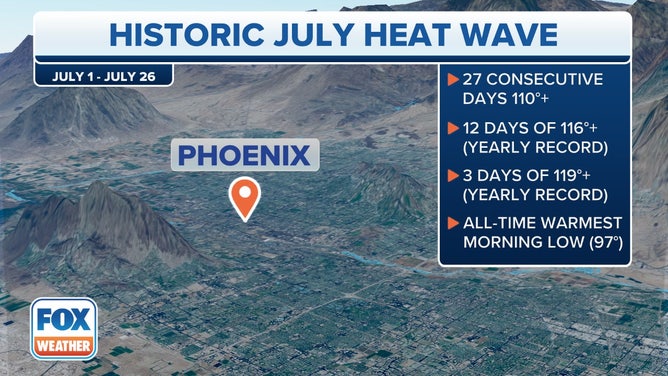
(FOX Weather)
They experienced a stretch from July 9-26 of not dropping below 90 degrees. Their overnight low of 97 on July 19 was their warmest low on record.
Oh, and it hasn't rained in Phoenix since March 22 (at least at Sky Harbor Airport; the suburbs recently had some monsoon storm rain). For PHX, the 128 days without measurable rain through Friday is their fourth-longest dry streak on record.
Not to be outdone, Reno tied their all-time record high of 108, while Grand Junction, Colorado, tied their all-time high of 107. Kingman, Arizona, set a new record of 114 degrees on July 15.
NWS has been busy sounding like a broken record
Another way to get perspective on the heat is this map by Iowa State University's IEM, showing the rank of the number of Heat Advisories issued for each NWS office since 2005.
A rating of 19 means they've issued the most heat advisories in the June-July period since 2005, while 1 means it's the fewest amount (likely zero alerts). You can see how busy they've been in the South.
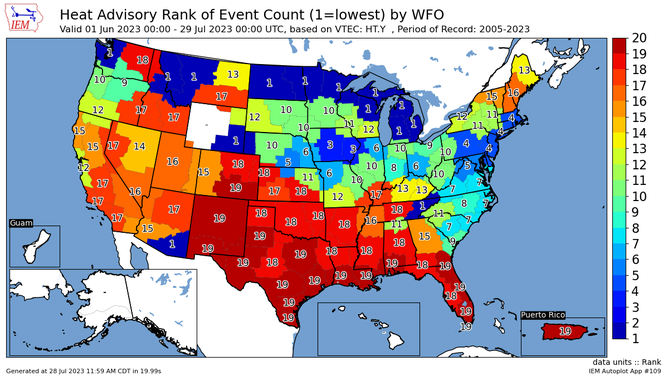
Rank from 1-19 on the number of Heat Advisories posted in the June-July time frame since 2005.
(IEM / Iowa State University / FOX Weather)
Cooler weather is in the offing next week. About 100 million will see above-average temperatures Monday and Tuesday versus 255 million earlier this week.
Need more weather? Check your local forecast plus 3D radar in the FOX Weather app. You can also watch FOX Weather wherever you go using the FOX Weather app at foxweather.com/live or on your favorite streaming service.
You can share your weather pictures and videos with us anytime, anywhere, in our America's Weather Watchers community on Facebook, email them to weather@fox.com or add the hashtag #FOXWeather to your post on your favorite social media platform.
